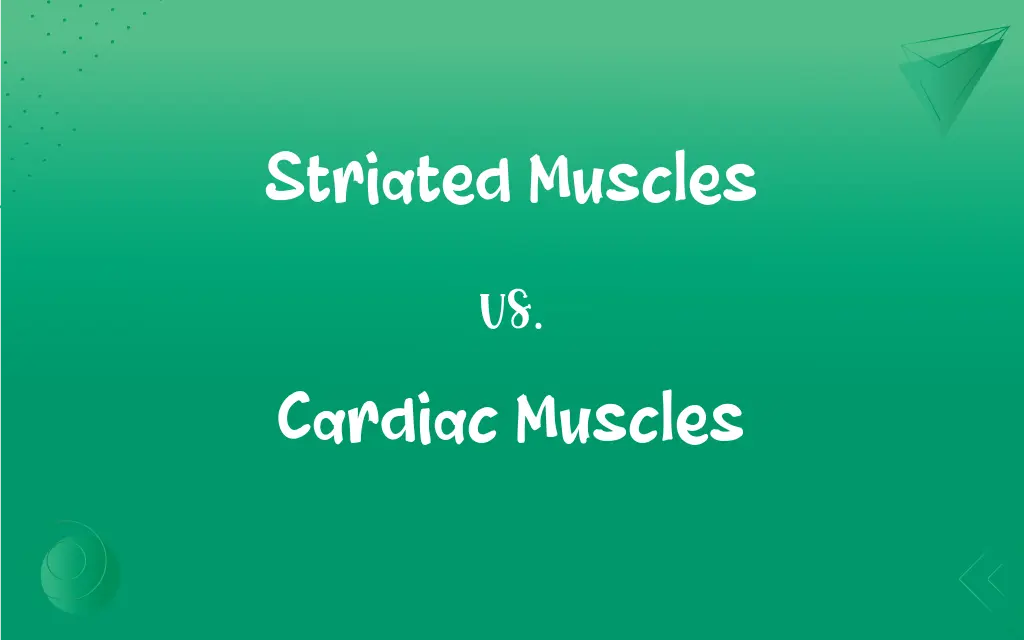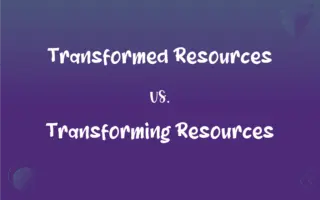Striated Muscles vs. Cardiac Muscles: What's the Difference?
Edited by Aimie Carlson || By Janet White || Published on March 17, 2024
Striated muscles are voluntary and controlled consciously, with a banded appearance; cardiac muscles are involuntary, found only in the heart, and beat rhythmically.

Key Differences
Striated muscles, also known as skeletal muscles, are characterized by their striped appearance under a microscope due to their highly organized fiber structure. These muscles are primarily involved in voluntary movements controlled by the nervous system. Cardiac muscles, found exclusively in the heart, also exhibit a striated appearance but differ in their function and control, being responsible for involuntary, rhythmic contractions that pump blood throughout the body.
The control of striated muscles is consciously regulated, allowing for deliberate actions like walking, lifting, or speaking. In contrast, cardiac muscles function autonomously, regulated by the heart's intrinsic electrical system and influenced by hormonal and neural signals, ensuring continuous and involuntary heartbeats.
Structurally, striated muscles are composed of long, cylindrical fibers that can vary in length and are multinucleated. Cardiac muscle fibers, on the other hand, are shorter, branched, and typically have a single nucleus. This specialized structure facilitates the synchronized contractions of the heart.
In terms of regeneration and repair, striated muscles have a greater capacity for repair and regeneration through satellite cells. Cardiac muscles have limited regenerative abilities, which is a significant factor in the severity of heart diseases.
The energy requirements and endurance of striated muscles vary, accommodating both fast, powerful movements and sustained activities. Cardiac muscles, however, are highly efficient and adapted for continuous activity, relying heavily on aerobic respiration to meet their energy needs consistently.
ADVERTISEMENT
Comparison Chart
Voluntary Control
Yes, controlled consciously
No, involuntary and automatic
Appearance
Striped or banded under a microscope
Also striated, but with branched fibers
Location
Throughout the body
Only in the heart
Nucleation
Multinucleated
Typically uninucleated
Energy and Endurance
Varied, both anaerobic and aerobic
Primarily aerobic, for endurance
ADVERTISEMENT
Striated Muscles and Cardiac Muscles Definitions
Striated Muscles
Banded muscles attached to bones.
Striated muscles contract to move different parts of the skeleton.
Cardiac Muscles
Endurance muscles relying on aerobic respiration.
Cardiac muscles continuously work without fatigue.
Striated Muscles
Voluntary muscles with a banded appearance.
Lifting weights exercises the striated muscles in the arms.
Cardiac Muscles
Specialized muscles for heart function.
Cardiac muscles are adapted for continuous activity.
Striated Muscles
Skeletal muscles under conscious control.
Striated muscles enable me to run and jump.
Cardiac Muscles
Uninucleated muscles in the heart wall.
Each cardiac muscle cell typically has a single nucleus.
Striated Muscles
Muscles with organized fiber structures.
The striated muscles' structure is visible under the microscope.
Cardiac Muscles
Heart muscles with a striated appearance.
The striations in cardiac muscles facilitate synchronized heartbeats.
Striated Muscles
Multinucleated muscle fibers.
Striated muscles have multiple nuclei within each fiber.
Cardiac Muscles
Involuntary muscles in the heart.
Cardiac muscles contract rhythmically to pump blood.
FAQs
How are striated muscles controlled?
Striated muscles are controlled by the nervous system and require conscious effort.
Are cardiac muscles voluntary?
No, cardiac muscles are involuntary and function autonomously.
What is the function of cardiac muscles?
Cardiac muscles are responsible for involuntary, rhythmic contractions to pump blood in the heart.
Where are striated muscles located?
Striated muscles are located throughout the body, attached to bones for movement.
What are striated muscles?
Striated muscles are voluntary muscles with a striped appearance, involved in conscious movement.
Can cardiac muscles function independently of the nervous system?
Cardiac muscles have their intrinsic electrical system but are influenced by neural and hormonal signals.
What is the structure of cardiac muscle cells?
Cardiac muscle cells are branched, typically uninucleated, and interconnected.
Can striated muscles regenerate?
Yes, striated muscles can regenerate and repair through satellite cells.
How do cardiac muscles contribute to heart health?
The efficient and rhythmic contractions of cardiac muscles are essential for maintaining heart health and blood circulation.
How does exercise affect striated muscles?
Exercise strengthens and increases the endurance of striated muscles.
Do cardiac muscles get tired?
Cardiac muscles are highly efficient and adapted for continuous activity without fatigue.
Are cardiac muscles striated?
Yes, cardiac muscles are striated but have a different structure compared to skeletal striated muscles.
What kind of respiration do striated muscles use?
Striated muscles use both anaerobic and aerobic respiration, depending on the activity.
What are the differences in nuclei between striated and cardiac muscles?
Striated muscles are multinucleated, while cardiac muscles are typically uninucleated.
Can striated muscles operate without oxygen?
Striated muscles can operate anaerobically for short periods during intense activity.
How do cardiac muscles meet their energy needs?
Cardiac muscles primarily rely on aerobic respiration for their continuous energy needs.
What causes striated muscles to contract?
Contraction in striated muscles is triggered by nerve impulses.
What role do cardiac muscles play in the cardiovascular system?
Cardiac muscles play a crucial role in pumping blood throughout the cardiovascular system.
How do diseases affect striated and cardiac muscles differently?
Diseases can lead to muscle weakness or dysfunction in striated muscles, while in cardiac muscles, they can affect heart rhythm and pumping efficiency.
Are striated muscles attached to bones?
Yes, striated muscles are usually attached to bones to facilitate movement.
About Author
Written by
Janet WhiteJanet White has been an esteemed writer and blogger for Difference Wiki. Holding a Master's degree in Science and Medical Journalism from the prestigious Boston University, she has consistently demonstrated her expertise and passion for her field. When she's not immersed in her work, Janet relishes her time exercising, delving into a good book, and cherishing moments with friends and family.
Edited by
Aimie CarlsonAimie Carlson, holding a master's degree in English literature, is a fervent English language enthusiast. She lends her writing talents to Difference Wiki, a prominent website that specializes in comparisons, offering readers insightful analyses that both captivate and inform.































































